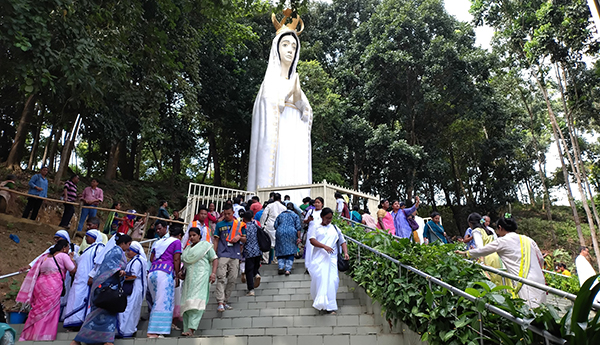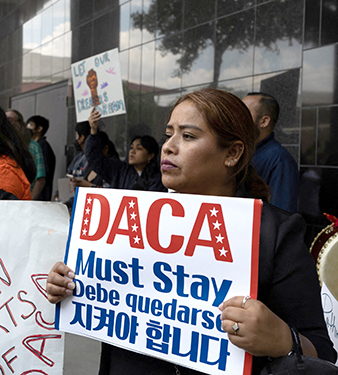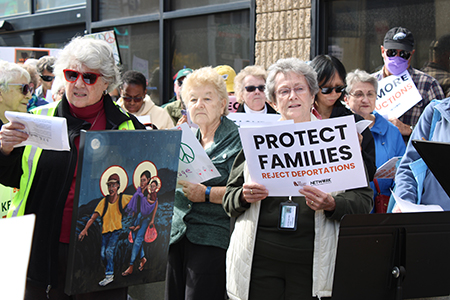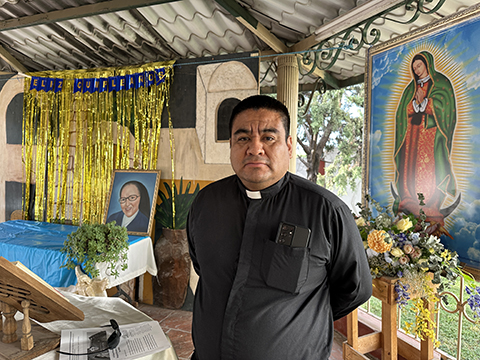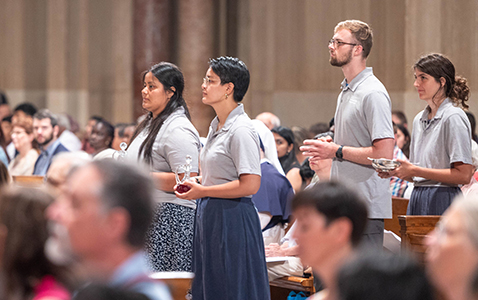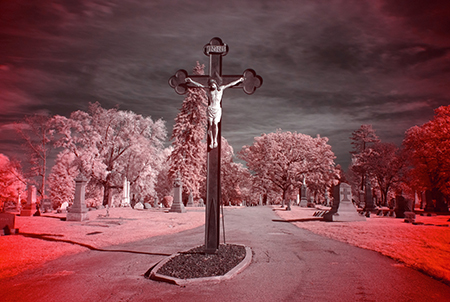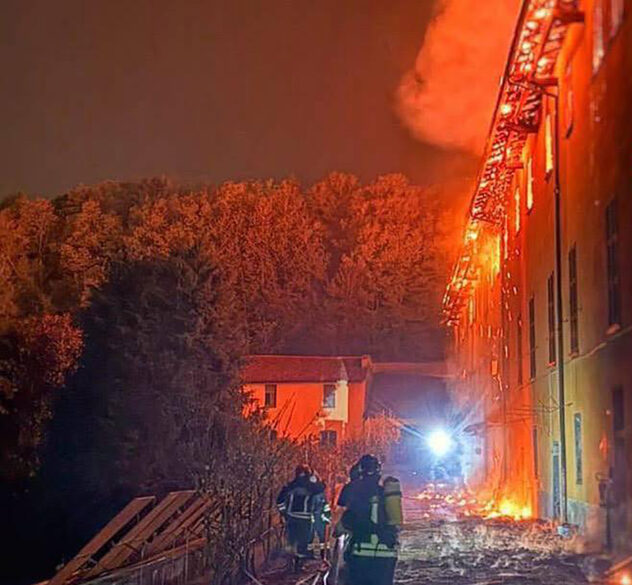By Peter Jesserer Smith
(OSV News) – From the start of the U.S. Catholic bishops’ fall plenary assembly to its end, a resounding concern for the God-given dignity of immigrants, and for unity in teaching the faith clearly and renewing the country spiritually, dominated the days’ proceedings.
The first order of business for the bishops, at the start of the Nov. 10-13 gathering was to invoke the intercession of the Holy Spirit. More than 320 active and retired bishops joined the opening Mass at the Basilica of the National Shrine of the Assumption of the Blessed Virgin Mary in Baltimore Nov. 10.
Archbishop Timothy P. Broglio, president of the USCCB and archbishop of the Archdiocese for the Military Services, reminded bishops in his opening homily of “their duty to be servants of truth,” and shared the story of a young airman who asked him “how to be a saint.”
The fall meeting was also Archbishop Broglio’s farewell as USCCB president after leading the bishops for the past three years through a National Eucharistic Revival, its first National Eucharistic Congress in more than eight decades, the recently concluded Synod on Synodality, and the election of the first American pope.
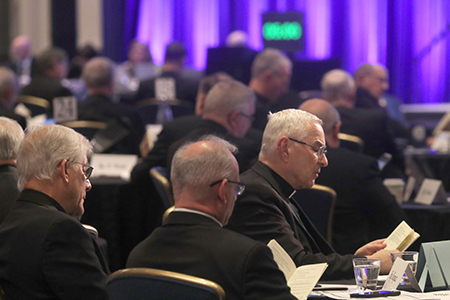
In his final presidential address, he emphasized the need for the bishops to model unity and help “convince people to listen to each other” amid polarization.
“We have to draw on our unity to illustrate that civil discourse is not only possible, but the most authentically human way forward,” he said.
For Cardinal Christophe Pierre, the papal ambassador, it was his first opportunity to address the bishops as Pope Leo XIV’s representative to the U.S. since the pope’s election in May. On the theme of unity, he emphasized continuity between the late Pope Francis and Pope Leo’s pontificates, while encourging them to look to the Second Vatican Council as their guide. As he has for the past several years, he encouraged them to develop a synodal culture that could help them unify the church at a time when many Catholics “identify more with tribes and ideologies than with the body of Christ.”
He said, “The synodal path invites us to a different way: a style of being church that makes communion concrete, allows dialogue to become discernment, and catholicity to become shared mission.”
The cardinal’s remarks about synodality, as a means to help the bishops bring about unity, were underscored by a Leadership Roundtable survey from the prior week. It showed that Catholics tend to give their parish pastors and parish high marks, yet a consistent “trust deficit” pattern prevails at the diocesan and national level.
The bishops elected new leadership for the next three years on Nov. 11, the first day of public meetings, choosing the conference’s secretary, Archbishop Paul S. Coakley of Oklahoma City, as their next president out of 10 possible candidates. Archbishop Coakley won on the third ballot in a close run-off with Bishop Daniel E. Flores of Brownsville, Texas. The bishops then decisively chose Bishop Flores, the conference’s former doctrine committee chair and its point man on implementing synodality in the U.S., as vice president, succeeding Baltimore Archbishop William E. Lori.
The following day, the bishops elected Bishop Kevin C. Rhoades of Fort Wayne-South Bend, Indiana, as their next secretary. Archbishop Alexander K. Sample of Portland, Oregon, was selected to succeed Bishop Rhoades as chair of the Committee on Religious Liberty. The bishops then elected five other committee chairs: Archbishop Jeffrey S. Grob of Milwaukee, for Canonical Affairs and Church Governance; Auxiliary Bishop Peter L. Smith of Portland, Oregon, for Ecumenical and Interreligious Affairs; Bishop William A. Wack of Pensacola-Tallahassee, Florida, for Evangelization and Catechesis; Ukrainian Catholic Metropolitan Archbishop Borys A. Gudziak of Philadelphia, for International Justice and Peace; and Bishop Mark W. O’Connell, newly named bishop of Albany, New York, for Protection of Children and Young People.
While many of the elections were close contests, the bishops’ voice on major issues – from teaching on immigration and gender ideology to public manifestations of Catholic witness and devotion – was overwhelmingly united in every vote.
On Nov. 12, the second public session of the gathering, the prelates approved a special pastoral message on immigration “to raise our voices in defense of God-given human dignity.” They amended the message on the floor to clearly condemn “indiscriminate mass deportation” alongside their call to end “dehumanizing rhetoric and violence, whether directed at immigrants or at law enforcement.”
The bishops applauded and many got to their feet after it passed with a resounding 216 votes in favor, five votes against, and three abstentions.
The bishops’ plenary assembly heard a report on the immigration situation in the U.S. under the Trump administration, as well as a new initiative of solidarity with migrants called “You Are Not Alone.” In a press conference, Bishop Rhoades also revealed that the issue of the ability of Catholic immigrants in ICE detention to receive sacraments “is now at the top of our concerns.”
“Obviously, the beliefs of the church have political consequences, but they’re not political in the usual sense of the word,” Archbishop Richard G. Henning of Boston told OSV News, explaining the bishops’ special message was “a pastoral address to our people rather than an attempt to lobby.”
The bishops also heard about promising signs of progress in their ongoing efforts to resolve backlogs for religious worker visas with the Trump administration. Close to 90% of the nation’s Catholic dioceses rely on foreign-born clergy and religious.
The bishops also heard a presentation on revisions to their “Ethical and Religious Directives for Catholic Health Care Services,” which they approved the following day. They approved the new ERDs – 206 bishops voted yes, with eight abstaining and seven opposing – with substantial revisions from the previous version. They incorporate guidance issued in 2023 by the USCCB’s Committee on Doctrine, which prohibited surgical or chemical interventions seeking to exchange or simulate the sex characteristics of a patient’s body for those of the opposite sex.
The bishops also learned that a new English version of the Bible will be called The Catholic American Bible, which aims to unify American Catholics’ reading of Scripture from the Bible they use in the home to the readings they pray with in the liturgy. They also learned that the Vatican approved the new English edition of the Liturgy of the Hours – concluding a 13-year process of revision – and it would be available for everyone by Easter 2027.
As the U.S. marks its 250th anniversary next year, the bishops voted to consecrate the nation to the Sacred Heart of Jesus in 2026, during their spring assembly in June, which concludes on the solemnity of the Most Sacred Heart of Jesus.
Before the bishops concluded the second and final day of public proceedings – the last day, Nov. 13, was spent in executive session – they approved holding an 11th National Eucharistic Congress in the summer of 2029 following a presentation by Bishop Andrew H. Cozzens of Crookston, Minnesota. Bishop Cozzens, chairman of the National Eucharistic Congress Inc., which will organize the event, said Nov. 12 that a “Revival Impact Study,” which will be made public in December, has shown that a great deal of fruit resulted from the National Eucharistic Revival effort, which included the 2024 National Eucharistic Congress in Indianapolis.
Bishop Cozzens said one of the gifts of the National Eucharistic Congress is the unity it brings to the whole church – something he saw at the 2024 event.
“I think we’ll experience that again in 2029,” he told OSV News. He said a theme is in development and the 2029 National Eucharistic Congress itself will be “a beautiful experience of the power of the Holy Spirit.”
(Peter Jesserer Smith is the national news editor for OSV News. OSV News’ Gretchen R. Crowe, Gina Christian, Kate Scanlon, Lauretta Brown and Julie Asher contributed to this report.)

